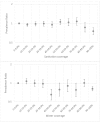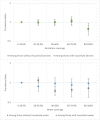Sanitation and water supply coverage thresholds associated with active trachoma: Modeling cross-sectional data from 13 countries
- PMID: 29357365
- PMCID: PMC5800679
- DOI: 10.1371/journal.pntd.0006110
Sanitation and water supply coverage thresholds associated with active trachoma: Modeling cross-sectional data from 13 countries
Abstract
Background: Facial cleanliness and sanitation are postulated to reduce trachoma transmission, but there are no previous data on community-level herd protection thresholds. We characterize associations between active trachoma, access to improved sanitation facilities, and access to improved water sources for the purpose of face washing, with the aim of estimating community-level or herd protection thresholds.
Methods and findings: We used cluster-sampled Global Trachoma Mapping Project data on 884,850 children aged 1-9 years from 354,990 households in 13 countries. We employed multivariable mixed-effects modified Poisson regression models to assess the relationships between water and sanitation coverage and trachomatous inflammation-follicular (TF). We observed lower TF prevalence among those with household-level access to improved sanitation (prevalence ratio, PR = 0.87; 95%CI: 0.83-0.91), and household-level access to an improved washing water source in the residence/yard (PR = 0.81; 95%CI: 0.75-0.88). Controlling for household-level water and latrine access, we found evidence of community-level protection against TF for children living in communities with high sanitation coverage (PR80-90% = 0.87; 95%CI: 0.73-1.02; PR90-100% = 0.76; 95%CI: 0.67-0.85). Community sanitation coverage levels greater than 80% were associated with herd protection against TF (PR = 0.77; 95%CI: 0.62-0.97)-that is, lower TF in individuals whose households lacked individual sanitation but who lived in communities with high sanitation coverage. For community-level water coverage, there was no apparent threshold, although we observed lower TF among several of the higher deciles of community-level water coverage.
Conclusions: Our study provides insights into the community water and sanitation coverage levels that might be required to best control trachoma. Our results suggest access to adequate water and sanitation can be important components in working towards the 2020 target of eliminating trachoma as a public health problem.
Conflict of interest statement
MCF has received funding as a consultant for WHO as part of separate assessments of sanitation on health. The authors alone are responsible for the views expressed in this article and they do not necessarily represent the views, decisions or policies of the institutions with which they are affiliated. The authors declare no other competing interests exist.
Figures





References
-
- World Health Organization (2017). "WHO Alliance for the Global Elimination of Trachoma by 2020: progress report on elimination of trachoma, 2014–2016." Wkly Epidemiol Rec 92(26): 359–368. - PubMed
-
- Bourne RR, Stevens GA, White RA, Smith JL, Flaxman SR, Price H, et al. Causes of vision loss worldwide, 1990–2010: a systematic analysis. Lancet Glob Health. 2013;1(6):e339–49. doi: 10.1016/S2214-109X(13)70113-X . - DOI - PubMed
-
- Muhammad N, Mpyet C, Adamu MD, William A, Umar MM, Goyol M, et al. Mapping Trachoma in Kaduna State, Nigeria: Results of 23 Local Government Area-Level, Population-Based Prevalence Surveys. Ophthalmic Epidemiol. 2016;23(sup1):46–54. doi: 10.1080/09286586.2016.1250918 . - DOI - PMC - PubMed
-
- Habtamu E, Wondie T, Aweke S, Tadesse Z, Zerihun M, Zewudie Z, et al. The Impact of Trachomatous Trichiasis on Quality of Life: A Case Control Study. PLoS Negl Trop Dis. 2015;9(11):e0004254 Epub 2015/11/23. doi: 10.1371/journal.pntd.0004254 ; PubMed Central PMCID: PMCPMC4657886. - DOI - PMC - PubMed
Publication types
MeSH terms
Grants and funding
LinkOut - more resources
Full Text Sources
Other Literature Sources
Research Materials
Miscellaneous

